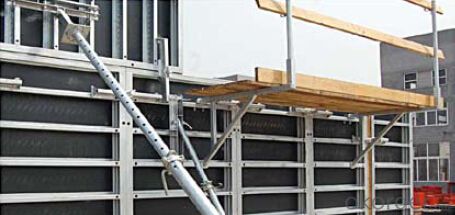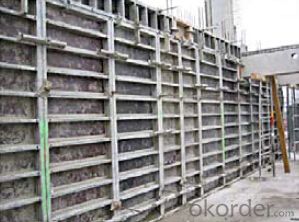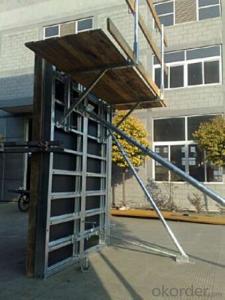Steel-Frame Formwork working platform
- Loading Port:
- China Main Port
- Payment Terms:
- TT OR LC
- Min Order Qty:
- -
- Supply Capability:
- -
OKorder Service Pledge
OKorder Financial Service
You Might Also Like
Steel-frame Formwork SF-140
Characteristics:
◆ Few parts for fast forming.
◆ Max. Concrete pressure: 80KN/m2.
◆ Hot-dip galvanized steel frame.
◆ The thickness of plywood is 18mm & the panel is 14cm.
◆ Compatibility with Hunnebeck Manto system due to similar edge profile.
System Details & Application:
◆ Neat joint and fast assembling with aligning panel clamp.
◆ Flexible panel arrangement and height extension.
◆ The selection of panels.
◆ Kinds of panel connectors.
◆ Corner clamp application.
◆ Length adjustment application.
◆ Height adjustment & aligning strut.
◆ Walkway bracket & platform.




- Q:What is the process for installing steel formwork?
- Installing steel formwork involves several steps that must be followed meticulously to achieve a successful and sturdy structure. To begin, the site must be prepared by clearing away any debris or obstacles that could hinder the installation process. It is essential to ensure that the ground is level and stable, providing a strong foundation for the formwork. Next, the steel formwork panels are positioned and firmly secured to create the desired shape and structure. This is typically achieved by connecting the panels using various types of connectors like bolts or clamps. Once the panels are securely connected, it is crucial to align and level the formwork accurately. This guarantees the stability and accuracy of the structure being formed. Specialized leveling devices, such as laser levels or spirit levels, can be utilized to ensure precise alignment and a square formwork. After achieving alignment, reinforcement bars (rebars) are placed within the formwork to enhance strength and support for the poured concrete. These rebars are positioned according to the structural drawings and are securely tied together using wire or metal ties. Once the reinforcement is complete, the concrete is poured into the formwork. Great care must be taken to ensure even pouring without any voids or air pockets. Concrete vibrators can be used to eliminate trapped air and ensure proper compaction. Once the concrete is poured, it needs to be appropriately cured to attain the desired strength and durability. This can be accomplished by covering the formwork with a curing compound or by implementing water curing methods, such as spraying water or covering it with wet burlap. Finally, after the concrete has cured, the formwork can be dismantled. This process involves carefully removing the formwork panels, connectors, and supports. The formwork panels can then be cleaned and stored for future use or transported off-site. Overall, the installation of steel formwork necessitates meticulous planning, precise alignment, and flawless execution to achieve a successful and structurally sound end result.
- Q:Is steel formwork easy to assemble and disassemble?
- Compared to other formwork systems, steel formwork offers a relatively simple assembly and disassembly process. By utilizing prefabricated panels, steel formwork can be easily connected and secured through various methods like clamps, pins, or wedges. These lightweight panels are also available in standardized sizes, ensuring convenient handling and transportation. Furthermore, steel formwork provides the advantage of adjustability and reusability. Adjustable screws or other mechanisms enable easy adaptation to different dimensions and shapes, granting flexibility in construction projects. Additionally, steel formwork can be utilized multiple times, significantly reducing the time and cost required for subsequent formwork installations. The disassembly process for steel formwork is also straightforward. Once the concrete has fully cured, the panels can be effortlessly removed by releasing the connecting mechanisms and dismantling the formwork system. Due to the lightweight nature of steel formwork panels, handling and removal are less labor-intensive compared to heavier materials like timber or plywood. In summary, the simplicity of assembly and disassembly makes steel formwork a highly favored choice for construction projects, particularly those that necessitate repetitive use and quick turnaround times.
- Q:How does steel formwork affect the overall sound insulation of the structure?
- The overall sound insulation of a structure is not directly influenced by steel formwork. The main purpose of steel formwork is to temporarily support and shape the concrete during construction. It is commonly used for concrete walls, slabs, columns, and beams. The sound insulation of a structure primarily depends on the materials used for walls, floors, and ceilings, as well as the design and construction techniques employed. These factors play a significant role in the transmission of sound waves and the overall acoustic performance of the building. Although steel formwork itself does not possess inherent sound insulation properties, it can indirectly impact the sound insulation of a structure during the construction phase. Improper installation or inadequate securing of the formwork may result in gaps or cracks in the concrete, which can compromise the sound insulation performance of the finished structure. However, it is essential to note that any potential impact on the sound insulation of the structure caused by steel formwork is temporary and can be resolved in subsequent stages of construction. This can be achieved by incorporating suitable acoustic insulation materials or employing soundproofing techniques. In conclusion, steel formwork does not directly affect the overall sound insulation of a structure. The sound insulation of a building is primarily determined by the materials and construction techniques utilized for walls, floors, and ceilings. Proper installation and subsequent measures can address any temporary impact on sound insulation caused by steel formwork during the construction process.
- Q:How does steel formwork affect the overall construction cost estimate?
- The overall construction cost estimate can be affected both positively and negatively by the use of steel formwork. On the positive side, steel formwork is known for its durability and reusability, which can result in long-term cost savings. Unlike traditional timber formwork, steel formwork can endure multiple uses, reducing the constant need for replacement and decreasing material expenses over time. Moreover, steel formwork offers better dimensional accuracy and stability, leading to quicker construction processes. This can result in shorter project durations and decreased labor costs, ultimately having a positive impact on the overall construction cost estimate. Nevertheless, it is important to consider that steel formwork generally incurs higher initial costs compared to timber formwork. The upfront investment required for steel formwork can be substantial, particularly for large-scale projects. This cost encompasses the acquisition or rental of the steel formwork system, transportation, and installation expenses. Additionally, the assembly and dismantling of steel formwork may necessitate skilled labor, which can contribute to higher labor costs. It is crucial to have experienced workers who are familiar with steel formwork systems, as any errors during the construction process can lead to added expenses and delays. Ultimately, the effect of steel formwork on the construction cost estimate relies on various factors such as the project's scale, duration, and the availability of skilled labor. Though steel formwork may involve higher upfront costs, the long-term advantages of durability, reusability, and enhanced construction efficiency can outweigh these initial expenses and positively impact the overall construction cost estimate.
- Q:What are the common design considerations for steel formwork in cold climates?
- Some common design considerations for steel formwork in cold climates include ensuring that the formwork is insulated to prevent freezing of the concrete, using materials that can withstand low temperatures and extreme weather conditions, incorporating measures to prevent ice formation on the formwork surface, allowing for thermal expansion and contraction of the steel, and considering the impact of cold temperatures on curing time and strength development of the concrete. Additionally, proper maintenance and protection of the formwork during winter months is crucial to ensure its longevity and effectiveness.
- Q:What are the common safety certifications required for steel formwork?
- To ensure the utmost safety on construction sites, steel formwork often necessitates various safety certifications. These certifications encompass the following: 1. OSHA Certification: The steel formwork must possess the Occupational Safety and Health Administration (OSHA) certification. This certification guarantees compliance with OSHA's safety standards, encompassing fall protection, proper scaffolding, and other safety measures. 2. ANSI Certification: Another indispensable requirement is the American National Standards Institute (ANSI) certification for steel formwork. ANSI establishes standards for diverse aspects of construction safety, including materials, equipment, and worker protection. An ANSI certification confirms conformity with these standards. 3. CSA Certification: When employing steel formwork in Canada, the Canadian Standards Association (CSA) certification is usually obligatory. This certification ensures compliance with CSA's safety standards, encompassing design, materials, and structural integrity. 4. CE Marking: The CE marking is an imperative certification for steel formwork employed in the European Union and other countries adhering to European standards. It signifies adherence to the European Union's essential health, safety, and environmental protection requirements. 5. ISO Certification: Although not directly related to safety, an ISO certification signifies that the manufacturer of the steel formwork has implemented a quality management system conforming to the International Organization for Standardization (ISO) standards. This certification guarantees consistent production of the formwork, meeting specific quality requirements. It is crucial to acknowledge that the precise certifications required for steel formwork may vary depending on the country, region, or project specifications. Consequently, consulting local regulations and project specifications is essential to determine the exact certifications necessary for steel formwork in a specific context.
- Q:How does steel formwork help in achieving a high-quality finish?
- Steel formwork helps in achieving a high-quality finish due to its ability to provide a strong and rigid structure for concrete placement. Its smooth and non-absorbent surface prevents the formation of air bubbles, resulting in a smooth and even finish. Additionally, steel formwork allows for precise and accurate shaping and alignment, ensuring the desired dimensions and contours of the final concrete product.
- Q:What are the considerations when designing steel formwork for retaining walls?
- When designing steel formwork for retaining walls, several important considerations should be taken into account: 1. Structural stability: The primary function of a retaining wall is to retain soil or other materials. Therefore, the steel formwork must be designed to withstand the lateral pressure exerted by the retained material. Adequate thickness, reinforcement, and bracing should be incorporated to ensure structural stability. 2. Load capacity: The formwork should be designed to support the weight of the concrete and any additional loads imposed during construction, such as equipment or workers. The steel formwork should be able to withstand these loads without deformation or failure. 3. Durability: Retaining walls are exposed to various environmental conditions, including moisture, temperature changes, and chemical exposure. The steel formwork should be designed to resist corrosion, rust, and other forms of deterioration over time. This may involve using corrosion-resistant steel or applying protective coatings. 4. Ease of construction: The design of the steel formwork should take into consideration the ease of assembly and disassembly. It should be structurally sound yet easy to install and remove. This will help save time and labor during construction. 5. Flexibility: Retaining walls may have different geometries and dimensions depending on the specific site conditions and design requirements. The steel formwork should be flexible enough to accommodate these variations. Adjustable connections or modular components can be used to achieve this flexibility. 6. Safety: Safety should be a top priority when designing steel formwork for retaining walls. Proper consideration should be given to factors such as fall protection, access, and working platforms to ensure the safety of workers during construction. 7. Cost-effectiveness: The design of the steel formwork should be optimized to minimize material usage and labor costs while still meeting the required strength and durability. This may involve using standard sizes and components, as well as incorporating reusable elements that can be utilized for multiple projects. By considering these factors, designers can ensure that the steel formwork for retaining walls is not only structurally sound and durable but also efficient and cost-effective.
- Q:What are the maintenance requirements for steel formwork?
- The maintenance requirements for steel formwork primarily involve regular cleaning and inspection. Firstly, it is essential to clean the steel formwork after each use to remove any concrete residue, dirt, or debris. This can be done by using water and a mild detergent, or alternatively, a high-pressure washer can be used for more stubborn stains. Additionally, it is crucial to inspect the steel formwork for any signs of wear, damage, or corrosion. This should be done before and after each use to ensure its structural integrity. Any rust or corrosion spots should be treated promptly by cleaning, sanding, and applying a rust inhibitor or paint to prevent further deterioration. Furthermore, the joints, connections, and fasteners of the steel formwork should be regularly checked to ensure tightness and proper functioning. Loose or damaged parts should be repaired or replaced as necessary. Storage is another important aspect of maintenance. Steel formwork should be stored in a dry and well-ventilated area to prevent rusting and corrosion. It is advisable to stack the formwork properly, with adequate spacing between each piece to prevent deformation and facilitate air circulation. Lastly, it is essential to follow the manufacturer's instructions and recommendations for maintenance and care. This includes using the formwork within its load-bearing capacity, avoiding excessive impact or rough handling, and adhering to any specific maintenance guidelines provided. By following these maintenance requirements, steel formwork can be kept in optimal condition, ensuring its durability, reliability, and longevity for future construction projects.
- Q:What are the standard dimensions of steel formwork panels?
- The standard dimensions of steel formwork panels can vary, but they are typically around 2.4 meters in length and 0.6 meters in width. The thickness of these panels can range from 12mm to 20mm. However, it is important to note that these dimensions can vary depending on the specific project requirements and the formwork manufacturer.
1. Manufacturer Overview |
|
|---|---|
| Location | |
| Year Established | |
| Annual Output Value | |
| Main Markets | |
| Company Certifications | |
2. Manufacturer Certificates |
|
|---|---|
| a) Certification Name | |
| Range | |
| Reference | |
| Validity Period | |
3. Manufacturer Capability |
|
|---|---|
| a)Trade Capacity | |
| Nearest Port | |
| Export Percentage | |
| No.of Employees in Trade Department | |
| Language Spoken: | |
| b)Factory Information | |
| Factory Size: | |
| No. of Production Lines | |
| Contract Manufacturing | |
| Product Price Range | |
Send your message to us
Steel-Frame Formwork working platform
- Loading Port:
- China Main Port
- Payment Terms:
- TT OR LC
- Min Order Qty:
- -
- Supply Capability:
- -
OKorder Service Pledge
OKorder Financial Service
Similar products
New products
Hot products
Related keywords






















